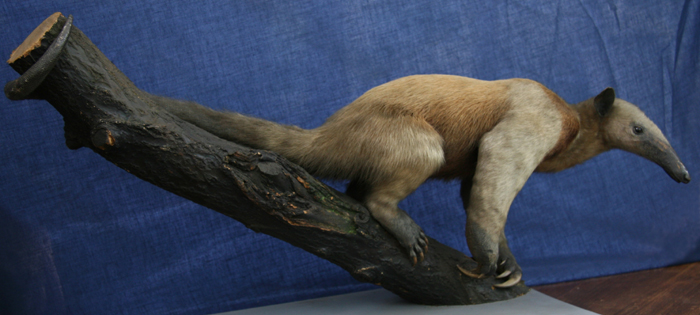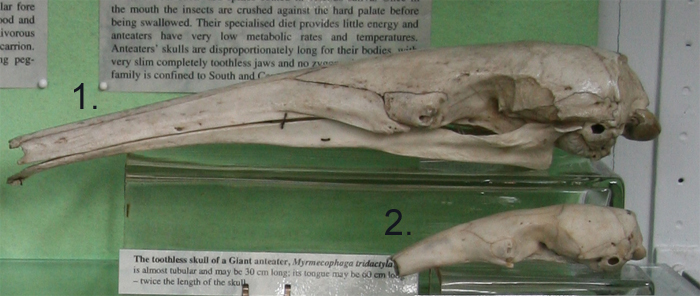
ANTEATERS
Family Myrmecophagidae: 4 species of anteaters in 3 genera.
Anteaters have very long snouts, with a minute mouth through which a very long tongue flicks in and out to capture prey, long bodies and limbs terminating in long claws. They feed on social insects, such as ants and termites. Giant anteaters, Myrmecophaga tridactyla, are terrestrial and active by day; the smaller tamanduas, Tamandua species, are partially arboreal and active by day and night. Anteaters are usually solitary: their home ranges depend upon the frequency of the termite and ant colonies. They live in South America - different species may sometimes share the same geographical distribution but they do not compete with each other because they behave differently and feed on different prey.
All anteaters can walk on the ground, dig and climb. They walk with their fingers flexed and turned inwards to keep their sharp claws from piercing their palms and touching the ground. All have five digits on their fore limbs and four or five digits on their hind limbs. Some digits are reduced and covered by skin and are invisible. Giant anteaters have large claws on the second and third digits; tamanduas have large claws on the second, third and fourth digits. As well as strong claws, tamanduas have powerful prehensile tails to give them additional purchase when climbing. When attacked anteaters rear up and strike out with their fore claws.

Tamandua sp. have the typical elongated structure of an anteater. They use their strong claws and prehensile tails to climb. The specimen in this photograph is downstairs in a Parasitology display case representing animals that carry parasites that can cause diseases in humans.
Anteaters use their long claws to dig holes in the nests of the ants and termites, on which they feed. They detect their prey by smell and use their very long tongues to lick up worker ants as the insects emerge, larvae and cocoons. Their tongues flick in and out very quickly - 150 times a minute – carrying the insects into the mouth where they are crushed against the hard palate before being swallowed.
Anteaters are discriminating and careful feeders, avoiding large jawed ants and termite soldiers. Giant anteaters feed on the largest bodied ants, tamanduas on medium-sized ants. Anteaters visit each nest only for a short period taking only a relatively few insects from each nest. As Giant anteaters need 35,000 insects a day and tamanduas need about 9,000 insects a day, the animals have to visit many colonies every day to satisfy their needs. However this behaviour ensures they cause little damage to each colony. An anteater’s stomach does not produce hydrochloric acid, but instead relies on the formic acid produced by the prey to help with digestion. These very specialised insect diets provide anteaters with little energy and they have very low metabolic rates and low temperatures. The Giant anteater has lowest temperature of any mammal: 32.7°C.
Anteaters’ skulls are disproportionately long for their bodies, with very slim completely toothless jaws and no zygomatic arches. Their mouths are just a tube through which a very long tongue extrudes to pick up termites and ants. The tongue is covered with minute backward spines coated in viscous saliva in which the prey is trapped. Their salivary glands are relatively larger that any other mammal. Anteaters ingest a large amount of food by a simplified and minimal jaw movement, which allows the tongue to move in and out very rapidly and the animals to swallow nearly continuously.

1. The toothless skull of a Giant anteater, Myrmecophaga tridactyla, is almost tubular and may be 30 cm long; its tongue may be 60 cm long – double the length of its skull.
2. The toothless skull of the much smaller tamandua is much shorter but the tongue may be 40 cm long.






